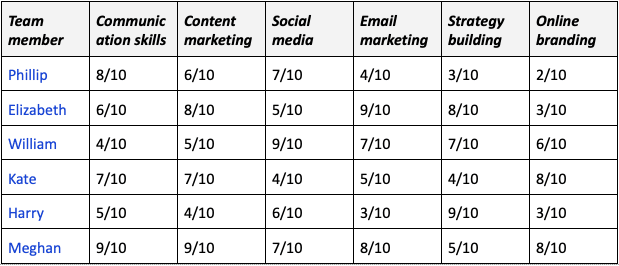
What is an employee skills matrix, you ask? Let us explain. Whether you are managing an entire business, a department, or a mere team, you must ensure your employees have the skills to succeed. Those who lack critical skills do not just hurt the current tasks at hand but also affect the long-term organizational goals.
A skills matrix helps you map out the skill level of your employees or specific teams to ensure everyone is equipped with the knowledge needed for successfully completing a job or an individual project.
Well-trained employees witness a boost in their productivity by 10%. They perform better and seek to switch jobs less often - resulting in a workforce that actually benefits the bottom line.
In this article, we will explore what a skills matrix is, why it is essential, and the steps you must remember to take to create a skills matrix for your team:
What is a skills matrix?
A skills matrix is a grid-based visual framework representing the skills an organization currently has access to and the skills that will be required in the future. Besides, it shows the proficiency level of every employee for each skill.
A skills matrix aims to streamline employee performance evaluation and make learning and development more effective.
What is an example of a skills matrix?
The tabular representation of employee skills is simple. Every skill an employee in a given role should possess is rated based on their aptitude - “beginner” to “expert.” For instance, you can rate using words like beginner, advanced, trainer, and expert or rate them numerically - from 1-10 or 1-5. Here is how a typical employee skill matrix chart looks:

A visual representation of every employee’s skills will help you place and promote them more efficiently. It allows you to organize training programs to bridge the skills gaps you might find. Set clear standards for all your ratings and apply them consistently across every job role and skill set. Be objective and avoid playing favorites.
What is the difference between a skills matrix and a competency matrix?
Although the concept is the same, the usage and level are different. For instance, a skills matrix basically represents the evaluation of the employees’ skills.
On the other hand, a competency matrix analyzes and summarizes an employee’s abilities, knowledge levels, and desires to add value. It is measured using academic qualifications, skill abilities, and desires.
Why does your business need an employee skills matrix?
Your business needs an employee skills matrix because evaluating employee performance on relevant skills can give your business a competitive advantage. Ever since the pandemic upended our world, companies have changed drastically.
For starters, layoffs became as common as working from home. The importance of hiring and retaining quality talent grew manifold. Fast forward to today, businesses have quickly employed a hybrid working model to give flexibility and creative freedom to their employees.
Businesses are revisiting their learning and development [L&D] strategy - revolving around learning what, learning when, and learning how. According to LinkedIn, 94% of professionals said they would stay longer if employers invested in their learning and development.
Just like a software application needs an upgrade from time to time, employees also need to adapt to the industry's latest developments, technologies, and tools. The top L&D professionals agree that upskilling and reskilling are their highest priorities.
However, it is not always easy for companies to determine what skills are needed to equip their workforce for future projects and challenges. An employee skills matrix helps them identify skills gaps, assign employees to appropriate projects, and build training programs.
What are the benefits of using an employee skills matrix?
Assessing every employee based on their skills and competencies can become challenging. A skills matrix allows them to quickly identify the skills gaps and determine how to fill them. But there are more benefits of using an employee skills matrix, including:
1. Employee appreciation
Employees gain a deeper insight into the value they are adding to your business and become fully aware of their skills to be successful in their job roles. A skills matrix helps create a sense of management in their development and identifies the training areas to focus on.
2. Empowered HR
Having an employee skills matrix guides HR in the right direction to design bespoke training programs or arrange for on-the-job training. They are well-aware of the general pulse of employees and take corrective measures to bridge the skills gap.
3. Higher team awareness
Individual professionals on a team become more aware of their weaknesses, taking extra caution to bridge the skills gap and positively contribute to the overall team performance. A skills matrix also helps managers mitigate critical person dependency and identify whether one employee relies on others on the team to complete essential tasks.
4. Improved internal mobility
A regularly updated skills matrix helps track employee skills and proficiencies across different departments within the company. This helps in internal mobility, which refers to the movement of employees within a company.
A skills matrix enables you to hire internal employees for new job roles or projects rather than externally undertaking the candidate selection process. When skills are mapped out, it becomes easier for employees to smoothly move across teams or projects. Plus, it is cost-effective for the company.
5. Happier employees
Setting up training for your employees that aligns with their strengths and interests can benefit your business because happy employees are more productive. They give their best shot when they enjoy what they do. Training also helps them receive recognition for skills they already possess, enhancing their engagement levels and self-esteem.
6. Reduced overheads
An employee skills matrix template lets you gather information quickly and easily, reducing overhead expenses. That is because HR managers do not need to follow up with each employee every few months to check skills gaps using a skills matrix.
7. Client satisfaction
Although there is no need for your clients to know about your employee skills matrix, they will benefit from superior customer service and high-quality products or services due to increased employee competency and productivity.
Ways to create a skills matrix template for your employees
Now that you know what a skills matrix is and how it benefits companies, how do you actually go about putting them into practice? Simply follow these three steps:
1. Assess the skills required for completing a project
Give a hard look at all the skills required for the role, department, or project. Be as specific as possible when creating the list. Please remember that soft skills such as teamwork, accountability, and communication are as important as knowing job-specific techniques or technologies. Start by mentioning the essential skills related to the role or business.
And then move on to include the skills you want your team or employees to possess. For instance, your software development team may be brilliant with JavaScript. But in the future, you may like to offer React Native development services to your clients.
So, that becomes a desirable skill. Speak to department heads or managers and ask them to create a list of skills required for different levels - beginner, intermediate, and advanced. This will help you highlight skills that might not get considered initially.
2. Create a grading system
This arrangement helps rank the skill level or competence of users. Some common ways to grade and categorize your employees in the skills matrix template are:
- Has basic knowledge but has not applied the skill at work (1)
- A person has applied the skill before but may need some help (2)
- Utilizes the skill and can work independently (3)
- Can coach others for that skill or process (4)
The numbers denote the competency level. Alternatively, you can ask employees to convey their interest level in a specific skill as interested (1) or disinterested (2). It is always better to employ multiple stages of evaluation.
For instance, if a marketing executive declares their interest and expertise in Google Ads, they should be tested for and assigned to projects requiring a Google Ads expert.
3. Add the data to a matrix
Going back to the example we discussed at the beginning of the article, designing an employee skill matrix chart is relatively easy. In the first row, mention all the skills for which the employees are being graded. In the first column, list the employee names.
The easiest way is to rate them numerically - from 1-10 or 1-5. Sort the skills into categories based on their contribution. You must be highly objective while doing this, as unconscious bias can creep in. There are several techniques you can utilize for grading employees:
- Have the team manager rate the employees.
- Let an employee grade every skill personally.
- Organize skill assessment tests to grade employees objectively.
- Collect team or client feedback and use it to evaluate employee skills.
Tips to keep in mind while creating skills matrices
Regardless of the solution you have chosen - spreadsheet, paper, or software - for building the skills matrix template, you must keep the following tips in mind:
- Humans are flawed beings. Not everyone can take on the same number of tasks or master the same number of skills.
- Skills matrices can turn out to be highly complicated if you do not heed caution. The best is to include only the principal skills, qualifications, and competencies of each role. Keep the soft and hard skills separate.
- Explain how the employee skill matrix chart has to be read. Sit with your team and explain the template’s nuances adequately.
Retrieve insights from the employee skill matrix chart
The matrix will give you a clear picture of what skills are available and what skills are missing. Host training programs that will help your employees hone their skills. Bring in a trainer or get an in-house expert to conduct a few workshops.
Over to you
An employee skill matrix chart visually represents which employees have the necessary competencies to complete specific tasks. You can use it for talent management, performance reviews, and organizational planning purposes.
The benefits of a skills matrix include increased productivity, better customer service, and less turnover because every employee is matched with their appropriate skill set and optimal employee engagement scores.
Devising an employee skills matrix template ensures you are placing people in positions where they will succeed while also identifying areas where leadership needs to improve when promoting employees or deciding who should fill open job roles.
FAQs
1. How do you create a skills matrix chart for employees?
Assess the skills required for completing a project. Create a grading system and rate each employee’s skill level. Add the data to a skills matrix template. Use the information from the chart to determine any missing skills required.
2. What skills should an employee have?
Besides having on-the-job technical skills, an employee should have strong critical thinking and problem-solving capabilities, oral and written communication skills, and a robust work ethic. They should be honest, ambitious, and highly accountable.
3. How do you track employee skills?
You can use certificates, surveys, skill assessments, and resumes to track how well your employees put their skills to work. This is especially helpful while tracking hard skills, i.e., the skills necessary for the job.

Asavari is an EiR at Adaface. She has made it her mission to help recruiters deploy candidate-friendly skill tests instead of trick-question based tests. When taking a break, she obsesses over art.
Spending too much time screening candidates?
We make it easy for you to find the best candidates in your pipeline-
with a 40 min skills test.


